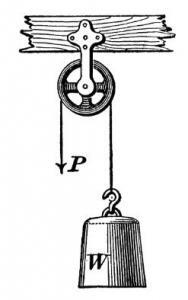No products in the cart.
Pulley
What is a Pulley?
A pulley is a simple machine consisting of a grooved wheel through which a rope runs. The pulley can be thought of as a kind of lever if one thinks of the grooved wheel as the fulcrum of the lever. Then the effort force is the force applied on one end of the pulley rope, and the resistance force is the weight that is lifted at the opposite end of the pulley rope.

In the simplest form of a pulley, the grooved wheel is attached to some immovable object, such as a ceiling or beam. When a person pulls down on one end of the pulley rope, an object at the opposite end of the rope is raised. In a fixed pulley of this design, the mechanical advantage is one. That is, a person can lift a weight equal to the force applied. The advantage of the pulley is one of direction. An object can be made to move upward or downward with such a pulley.

In a movable pulley, one end of the pulley rope is attached to a stationary object (such as a ceiling or beam), and the grooved wheel is free to move along the rope. When a person lifts on the free end of the rope, the grooved wheel and any attached weight slide upward on the rope. The mechanical advantage of this kind of pulley is two. That is, a person can lift twice as much weight as the force applied on the free end of the pulley rope.

Example of a movable pulley
What is a Lever?
A lever is a simple machine made of a rigid beam and a fulcrum. The effort (input force) and load (output force) are applied to either end of the beam. The fulcrum is the point on which the beam pivots. When an effort is applied to one end of the lever, a load is applied at the other end of the lever. This will move a mass upward.

What is mechanical advantage?
A lever provides mechanical advantage. Mechanical advantage refers to how much a simple machine multiplies an applied force. The location of the effort, load, and fulcrum will determine the type of lever and the amount of mechanical advantage the machine has. The farther the effort is away from the fulcrum, the easier it is to move the load.

SELF-PROJECT
Problem
Which pulley setup makes lifting a heavy load easiest?
Materials
- 2 tall surfaces of the same height (tables, counter tops, or a counter top and a table)
- 3 2”x4” wood planks, long enough to span the distance between the tall surfaces
- 4 fixed pulleys
- 2 movable pulleys
- Rope that fits the pulleys
- Screws
- Screwdriver
- Toolbox with handle or, a small bucket
- Tools, books, and other objects to add weight to the toolbox/bucket
Procedure
-
Fixed pulley
- Using the screws and a screwdriver, attach one fixed pulley to the center of a 2×4 plank.
- Feed the rope through the pulley.
- Attach one end of the rope to the toolbox handle.
- Place a few objects in the toolbox until it feels heavy.
- Set the wooden plank between your two tall surfaces so the pulley is facing down.
- Pull down on the free end of the rope and lift the toolbox.

-
Movable Pulley
- Using the screws and your screwdriver, attach one fixed pulley to a point slightly off-center on one of your 2×4 plank.
- Feed the rope through the pulley.
- Feed one end of the rope through a movable pulley.
- Attach the end of the rope fed through the movable pulled to the 2×4 plank, about 1 foot away from the fixed pulley.
- Set the wooden plank between two high surfaces so the pulleys are facing down. The movable pulley will hang down like this.
- Attach the handle of the toolbox to the movable pulley.
- Place the same objects in the toolbox to easily conclude things later on.
- Pull down on the free end of the rope and lift the toolbox.

Results
The fixed pulley will make the toolbox most difficult to lift. The movable pulley will make the toolbox easier to lift.
Why?
Movable pulleys give you a mechanical advantage, which is a measure of performance for machines. Having a mechanical advantage means the force applied by the system is greater than the force you put in. In a pulley system, this means the pulley can lift the object with a greater amount of force than you apply to the rope. This allows you to lift heavy things more easily.
